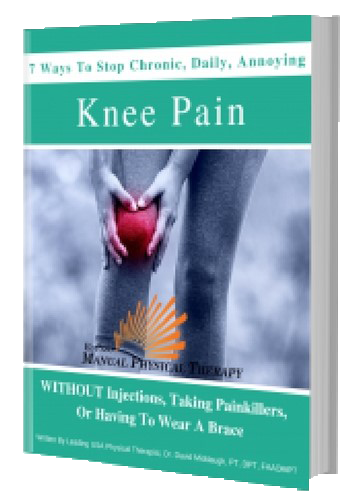TAP TO CALL (915) 503-1314

WILL MY KNEE BE PAIN FREE AFTER KNEE REPLACEMENT SURGERY?
Will my knee be pain free after knee replacement surgery? I often get this question from people that have recently had a knee replacement surgery, or those that are suffering with knee arthritis and are looking to learn more about having a knee replacement surgery.
And what you need to know is that recent research from 2020 tells us that anywhere from 6% to 30% of people that have had a knee replacement experience discontentment one year after having the knee replacement, and many of those are because they’re still having pain problems even a year after the knee replacement.
Let me tell you what you can expect after having knee replacement. Of course, immediately after the surgery and in the months after, you’re going to have pain and limitations from just healing from the surgery, it’s going to take you some time to get your mobility back to be able to walk normally, again, you’re going to be on a walker immediately after the surgery, probably a cane for a while after that.
And usually about three to six months is when people begin to walk without a walker or a cane. If they’ve been doing that before, if you’ve been using a walker cane before, chances are you’re going to be on a walker or a cane even longer than six months. And generally people that have had a knee replacement will say that even as it normalizes and as the weeks go by months go by that that knee just doesn’t feel like a normal knee, it feels like there’s something in there.
They don’t necessarily say that it’s bothersome or something that stops them from doing their daily activities unless they’re dealing with some flare up. But they’ll say that it just feels a bit strange.
And it takes some getting used to now if your knee arthritis was severe, whatever problem you had, leading up to the knee replacement, usually people are very content with a knee replacement afterwards, because the problem that they were dealing with before was so bad that even though they might have some pain or some limitations after having a knee replacement, it’s much better than the situation they were in before.
So in that case, they’re happy, they’re content, and usually very grateful that they were able to have a knee replacement surgery. Now there still are people that have had severe pain and continue to have equal even worse pain after the knee replacement surgery. And for those we need to reset expectations about why the pain is so bad now after having surgery, and what can be done to help the situation without having another surgery.
Now you were likely told that within three to six months after having the knee replacement, you’re going to be back to normal back to doing things that’s what surgeons often tell their patients. And it is a case for some but usually you have to double, triple or even quadruple that timeframe.
Most people aren’t feeling a lot more normal until about 12 months after having knee replacement surgery. And many take even two years to adjust to their new knee where they feel confident enough to go do many of the things that they were doing before having the knee replacement surgery.
What your surgeon can’t tell you about having a knee replacement surgery is that it’s possible to still make improvements even though it’s been a year or two past your surgery. Oftentimes when people are still suffering with chronic pain problems after knee replacement surgery, doctors surgeons kind of don’t know what else to do because they’ve already done their part.
What they can’t tell you is that you probably have a muscle imbalance in your leg that’s affecting the pressures at your knee joint. The way this muscle imbalance works is often the quad muscles and sometimes even the hamstring muscles.
Basically the muscles on the thigh are too strong and they’re compressing the knee joint in the kneecap excessively. And even though you’ve had a knee replacement other tissues are getting affected the tendons and ligaments, the interface between the hardware that was installed and where the bone is where that meets that can be affected as well.
It’s still very possible for you to get tendinitis and bursitis and have muscle and even nerve problems. Another way to think of this muscle imbalance is a compensation that’s when certain muscles are having to do the work for other muscles. When those thigh muscles are being overused, it’s very often because muscles up in the hip, usually the glute muscles and even down into the foot.
The ones that hold up the arch aren’t as strong as they should be and it’s causing thigh muscles to have to do extra work in order for you to do your daily activities as you use your leg. Focusing on correcting this muscle imbalance is often a key factor in improving chronic knee pain after having a knee replacement because chances are you had this muscle imbalance already.
This is what causes a knee arthritis that eventually sets you up to have a knee replacement. So if you can go and fix that muscle imbalance correct those compensations then you’re going to be in a much better position and possibly not have any problems after having your knee replacement and be able to live a more normal life with your knee replacements.
I talk extensively about muscle imbalances as they pertain to knee replacements here on this channel. You can go find a playlist of all our knee replacement help videos down in the description below. I’ve also got a comprehensive program called the failed knee replacement recovery program. There’s a link for that in the description below too.
If this video was helpful for you, please give us a thumbs up. Tell us that you liked it. Share this with somebody you think needs to hear this. And don’t forget to subscribe and turn on your notification bell so that you don’t miss out on any of the helpful videos that we post each and every week. Thanks so much for watching. I’ll see you in the next video. Bye bye!
Would You Like To Talk With A Specialist?
Appointments and Questions Call: (915)503-1314
EL PASO MANUAL PHYSICAL THERAPY
2601 E. Yandell Drive, Suite 232
El Paso, Texas 79903
© 2023 El Paso Manual Physical Therapy, PLLC, All Rights Reserved
